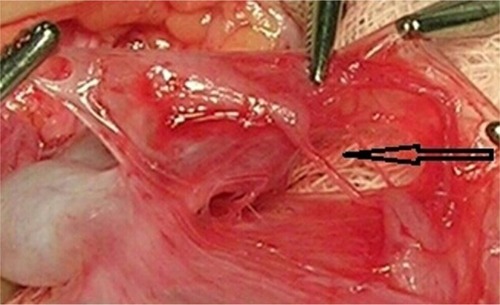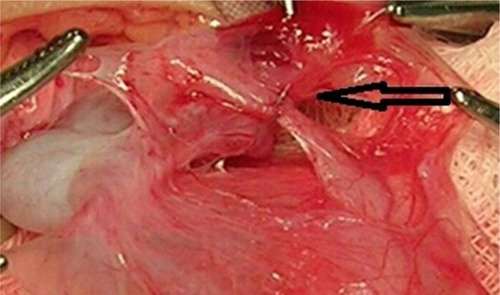Abstract
We report a case of a 2-year-old boy who presented with an empty left scrotum. Clinical examination revealed a left palpable undescended testis. During orchidopexy, segmental atresia of the vas deferens was found, and microsurgical repair was carried out. Segmental vasal atresia is an extremely rare condition and is infrequently diagnosed, especially in the pediatric age group. This is the first reported case of segmental vasal atresia without an association with cystic fibrosis.
Case history
A 2-year-old boy presented with a history of an empty left scrotum since birth.
General physical examination was unremarkable, and local examination revealed a left hypoplastic scrotum with a normal-sized left testis palpated in the groin. The right testis was normal in location and size. Routine blood investigations were within normal limits, and no abnormality was detected on abdominal ultrasound. A conventional orchidopexy was planned.
Orchidolysis was carried out through a left inguinal incision. Upon examination of the left testis and epididymovasal system, the left testis was found to be normal in size, shape, and consistency. A defect in the continuity of the vas deferens near the epididymis was found (), in that the peritoneum opened over the vas deferens. A very thin fibrotic band connecting both ends of the vasal defect was isolated () and microsurgically resected by end to end anastomosis using 9-0 polyglactin () to establish normal vas continuity.
Figure 1 A defect in the continuity of the vas deferens near the epididymis.

Figure 2 A very thin fibrotic band connecting both ends of the vasal defect was isolated.

Figure 3 The thin fibrotic band connecting both ends of the vasal defect was microsurgically resected by end to end anastomosis using 9-0 polyglactin to establish normal vas continuity.

The result of a sweat chloride test was normal, and histopathology confirmed the fibrotic consistency of the resected band.
After a 1-month follow-up interval, the patient showed no respiratory or gastrointestinal symptoms of cystic fibrosis (CF). In addition, the family was counseled regarding the low possibility of infertility in the future.
Discussion
Segmental vasal atresia is an extremely rare congenital anomaly and has been infrequently reported in the pediatric age group. A range of vas deferens anomalies can be seen in cryptorchid patients, eg, congenital bilateral or unilateral absence of vas deferens and ectopic, duplication, diverticulum, or segmental aplasia of vas deferens.Citation1
The cryptorchid testicle has structural and functional alterations, and the rate of infertility is inversely proportional to the age at the time of orchidopexy.Citation2 The highest fertility indexes are reported with therapy before the age of 2 years.Citation3 Azoospermia is present in about 18%–20% of adults operated upon for bilateral cryptorchidism. The prognosis of future fertility should be considered when epididymovasal anomalies are detected at orchiopexy, and the incidence of epididymal and vasal abnormalities in undescended testicles is (19%).Citation4 Flimsy attachment of the head of epididymis to the testis constituted the most common anomaly.Citation5
We could not find a similar segmental vasal atresia without CF in a review of the pediatric literature. It is advisable to evaluate the vas for its presence bilaterally and palpate along its entire length to check for defects preoperatively. Hunter reported congenital absence of the vas deferens (agenesis) as long ago as 1737.Citation6 Congenital bilateral absence of the vas deferens (CBAVD) is a genital form of CF.Citation7 CBAVD is a frequent cause of obstructive azoospermia, and is generated by mutations in the CF transmembrane conductance regulator gene.Citation8 Also, congenital unilateral absence of the vas deferens has been reported.Citation9 Approximately 10% of obstructive azoospermia is congenital and due to mutations in the CF gene.Citation10 A small subset of men without known CF transmembrane conductance regulator defects may exhibit CBAVD.Citation11
Conclusion
Segmental vasal atresia is a rare condition. Careful examination of the testis and epididymovasal system is essential to look for associated anomalies while, at the the same time, providing treatment.
Disclosure
The authors report no conflicts of interest in this work.
References
- RadpourRGourabiHDizajAVHolzgreveWZhongXYGenetic investigations of CFTR mutations in congenital absence of vas deferens, uterus, and vagina as a cause of infertilityJ Androl200829550651318567645
- La VigneraSCalogeroAECondorelliRCryptorchidism and its long-term complicationsEur Rev Med Pharmacol Sci200913535135619961040
- SchwentnerCOswaldJKreczyANeoadjuvant gonadotropin-releasing hormone therapy before surgery may improve the fertility index in undescended testes: a prospective randomized trialJ Urol2005173397497715711353
- BelloliGD’AgostinoSCampobassoPEpididymal and vasal abnormalities in undescended testes and azoospermiaPediatr Surg Int199499598
- MollaeianMMehrabiVElahiBSignificance of epididymal and ductal anomalies associated with undescended testis: study in 652 casesUrology19944368578607910991
- HunterJOn the glands called vesiculae seminalesPalmerJFComplete Works4LondonLongman, Reese, Orm, Brown, Green, and Longman17372034
- VohraSMorgentalerACongenital anomalies of the vas deferens, epididymis, and seminal vesiclesUrology19974933133219123691
- LopezEViartVGuittardCVariants in CFTR untranslated regions are associated with congenital bilateral absence of the vas deferensJ Med Genet201148315215920972246
- RotmanAHutsonJCongenital unilateral absence of the vas deferensANZ J Surg201080319719820575934
- McCallumTMilunskyJMunarrizRCarsonRSadeghi-NejadHOatesRUnilateral renal agenesis associated with congenital bilateral absence of the vas deferens: phenotypic findings and genetic considerationsHum Reprod200116228228811157821
- HavasiVRoweSMKolettisPNAssociation of cystic fibrosis genetic modifiers with congenital bilateral absence of the vas deferensFertil Steril20109462122212720100616
